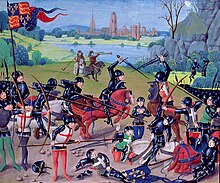Henry Vaughan was a Welsh metaphysical poet, author and translator writing in English, and a medical physician. His religious poetry appeared in Silex Scintillans in 1650, with a second part in 1655. In 1646 his Poems, with the Tenth Satire of Juvenal Englished was published. Meanwhile he had been persuaded by reading the religious poet George Herbert to renounce "idle verse". The prose Mount of Olives and Solitary Devotions (1652) show his authenticity and depth of convictions. Two more volumes of secular verse followed, ostensibly without his sanction, but it is his religious verse that has been acclaimed. He also translated short moral and religious works and two medical works in prose. In the 1650s he began a lifelong medical practice.

Dafydd ap Llewelyn ap Hywel, better known as Dafydd Gam, anglicized to David or Davy Gam, was a Welsh warrior, a prominent opponent of Owain Glyndŵr. He died at the Battle of Agincourt fighting for Henry V, King of England in that victory against the French.

Sir William ap Thomas was a Welsh nobleman, politician, knight, and courtier. He was a member of the Welsh gentry family that came to be known as the Herbert family through his son William Herbert, 1st Earl of Pembroke and is the agnatic ancestor, via an illegitimate descendant of the 1st Earl of the 8th creation, of the current Herbert family of the Earl of Pembroke and Montgomery, and also of the Herbert Earl of Carnarvon.
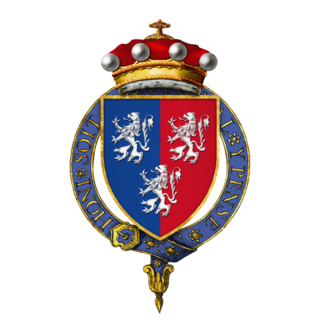
William Herbert, 1st Earl of PembrokeKG, known as "Black William", was a Welsh nobleman, soldier, politician, and courtier.
Sir Gruffudd Vychan, also spelt in English sources as Griffith Vaughan, was a Welsh knight who supported the rebellion of Prince Owain Glyndŵr against the English, and captured the Lollard John Oldcastle, who was later immortalized by Shakespeare as John Falstaff. He was finally executed after the murder of Sir Christopher Talbot, son of John Talbot, 1st Earl of Shrewsbury.

The Battle of Pwll Melyn was a battle between the Welsh and English on 5 May 1405, it was part of the Glyndŵr Rising that lasted from 1400 to 1415. It was the first English victory in a pitched battle during the war. The battle resulted in heavy casualties for the Welsh including the loss of two important commanders.
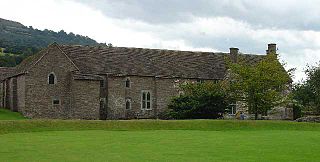
Tretower Court is a medieval fortified manor house in Wales, situated in the village of Tretower, near Crickhowell in modern-day Powys, previously within the historical county of Breconshire or Brecknockshire.
This article is about the particular significance of the century 1401–1500 to Wales and its people.

The Glyndŵr rebellion was a Welsh rebellion led by Owain Glyndŵr against the Kingdom of England during the Late Middle Ages. During the rebellion's height between 1403 and 1406, Owain exercised control over the majority of Wales after capturing several of the most powerful English castles in the country, and formed a national parliament at Machynlleth. The revolt was the last major manifestation of a Welsh independence before the annexation of Wales into England in 1543.

Sir Thomas de Strickland was an English soldier. He is best known for carrying the banner of St. George at the battle of Agincourt.
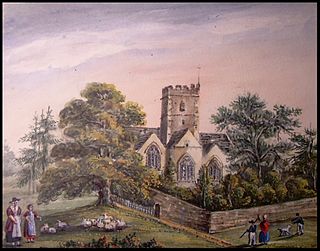
Gwladys ferch Dafydd Gam was a Welsh noblewoman. She was the daughter of Dafydd ap Llewelyn ap Hywel, otherwise known as Dafydd Gam, who was killed at the Battle of Agincourt in 1415.

Sir Roger Vaughan of Tretower Court, was the son of Welsh noblewoman Gwladys ferch Dafydd Gam and Sir Roger Vaughan of Bredwardine, who fought and died with Gwladys's father, Dafydd Gam in the Battle of Agincourt in 1415.
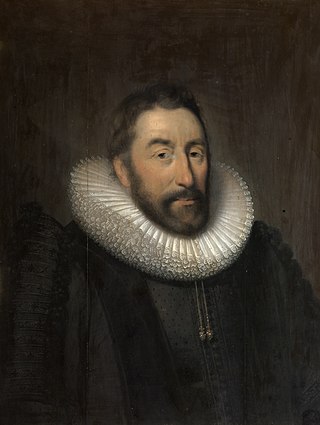
Sir Walter Pye of The Mynde, Herefordshire was an English barrister, courtier, administrator and politician who sat in the House of Commons from 1621 and 1629.
Sir Charles Vaughan (1584-1630) was a Welsh landowner and politician who sat in the House of Commons in 1614 and 1625.
Roger Vaughan (1834–1883) was an English Benedictine monk of Downside Abbey and Roman Catholic Archbishop of Sydney, 1877–1883.
Colonel Henry Cornewall was an English soldier, courtier and Member of Parliament.

Sir Richard Herbert of Coldbrook Park, near Abergavenny, was a 15th-century Welsh knight, and the lineal ancestor of the Herberts of Chirbury.
Huw Cae Llwyd was a Welsh language poet from Llandderfel in the Dee valley of Merioneth as he witnessed in his Cywydd y Wennol.

Newton house near Brecon in Powys is an important Grade I listed 16th Century house which retains much of its original features including a screen, plasterwork, carvings and inscriptions.
Roger Vaughan JP DL was an English politician and courtier who was a Member of Parliament for Hereford.


